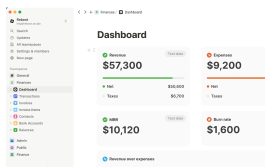As a mobile reseller, you know how to juggle. Maybe not circus balls or flaming torches, but you’re definitely juggling inventory sourcing, sales processing, customer management, and more.
Drop one torch — I mean task — and soon, your whole store is metaphorically on fire.
If the resale inventory management shuffle gives you a headache, you’re not alone. But it doesn’t have to be such a struggle. With the right tools and best practices, you can manage your resale inventory smoothly, keeping customers happy and profit margins healthy.
This post covers 20 tips and tools for resale inventory management. We’ll also discuss what you need from an inventory management tool, which will give you everything you need to set yourself up for success.
Best Tools for Resale Inventory Management
Robust inventory management is critical for any business. When you’re managing resale electronics, these processes are doubly important. Resale inventory management is a delicate balance of tracking parts, legacy technology, open-box sales, and more. But with so many tools available on the market, how can you find the best one for your business?
First, let's consider the tools you need for effective inventory management. The right software can help you track stock levels, monitor pricing and sales, and streamline your listing process across multiple channels.
Some key software inventory management features to look for include:
- Integrated product photos: The ability to easily add and manage product images within your inventory management system. This integration saves time and helps make your product listings consistent.
- IMEI/serialized number tracking: Tracking and managing these numbers is critical for resellers dealing with mobile devices and other electronics with unique serial numbers.
- Selling price tracking: To stay competitive and maximize profits, you need to be able to monitor and adjust your selling prices easily based on market trends and other factors.
- Multi-channel inventory sync: If you sell on multiple platforms (e.g., your website, Amazon, and eBay), you'll want a tool that automatically syncs your inventory levels across all channels.
- Cloud-based access: Accessing your inventory management system from anywhere, on any device, gives you more insight and access to your data.
- Bulk listing updates: The ability to make bulk updates to your product listings (e.g., pricing changes and description edits) can save you time and effort.
- Kitting and bundling features: A tool that can handle complex inventory relationships is essential for resellers who offer product bundles or kits.
- Customer image capture: Capturing and storing images of customer devices left in your store for repair can help with tracking, organization, and technician accountability.
- State ID image capture: Being able to take and store images of your customers' State IDs helps you maintain accurate customer records.
- Custom barcode and label printer: The ability to generate and print custom barcodes helps streamline inventory receiving and management.
While many inventory management tools are available, one that stands out for mobile repair shops and electronics resellers is CellSmart POS. Designed specifically for mobile and electronics repair shops, CellSmart POS offers all of the features mentioned above and more within a single, integrated platform.
See how CellSmart POS can help you streamline your resale inventory management processes with a free software demo.
With all this in mind, let’s explore our expert tips for managing resale inventory in your store.
Inventory Management and Tracking Tips:
One of the most critical elements of inventory management is effective inventory tracking. If you want to track your inventory effectively, you need a barcode-scanning system.
Barcodes make tracking your stock more accurate and streamline your tallying and tracking processes, saving you time and effort. Barcode scanning helps you minimize human error and keep your inventory records up-to-date with each sale or purchase.
Another tip is to use cloud-based inventory management software, which gives you real-time visibility and accessibility from anywhere with internet access. With cloud-based software, you can track your inventory levels, set reorder points, and generate reports from any device with an internet connection. This flexibility is particularly useful if you have multiple locations.
Related Read: Cloud vs. Server POS System: 14 Pros and Cons to Consider
Though a robust inventory management solution will help you keep your records in order, you’ll still need to conduct regular physical inventory counts to make sure your records are accurate. While it may seem time-consuming, scheduling periodic counts can help you catch errors, find theft or damage incidents, and adjust your records as needed.
Key Takeaways:
- Implement a barcode scanning system for accuracy and efficiency
- Use cloud-based inventory management software for real-time visibility and accessibility
- Conduct regular physical inventory counts to ensure accuracy
- Utilize mobile or cloud-based tools for on-the-go tracking and updates
Product Sourcing and Procurement Tips:
Finding the right used and resale products for your business is crucial, and one of the best ways to ensure consistent quality and availability is to establish relationships with reliable suppliers. But how can you find the right suppliers and develop those relationships?
Before committing to a partnership, research potential suppliers, compare prices and terms, and ask for references or samples. Building solid relationships with your suppliers can lead to better pricing, faster shipping times, and access to exclusive products or deals.
You can also attend trade shows and conferences to discover new products and stay up to date on industry trends. These events also provide valuable opportunities to network with suppliers, manufacturers, and other business owners in your industry.
Related Read: 7 Tips for Managing an Electronics Repair Business
Another way to find unique or discounted products is to explore online marketplaces and liquidation websites. These platforms often offer various products at competitive prices, but do your due diligence and read reviews before purchasing.
As you work with different suppliers and marketplaces, monitor their performance. Rate each supplier based on price, quality, and reliability. Review your supplier relationships regularly, and don't be afraid to make changes if a supplier is no longer meeting your needs or expectations.
Key Takeaways:
- Establish relationships with reliable suppliers
- Attend trade shows and conferences to discover new products
- Utilize online marketplaces and liquidation websites for unique or discounted products
- Implement a system for evaluating and tracking supplier performance
Pricing and Profitability Tips:
Pricing can be tricky in any industry, but it’s especially challenging in resale. The best way to get started on pricing is by conducting market research.
Start by analyzing your competitors' prices for similar products and considering factors like quality, features, and target audience. You may also want to survey your customers to gauge their willingness to pay and identify any potential barriers to purchase.
You can also use dynamic pricing technology and tools to optimize your prices based on demand, competition, and other factors.
These tools can help you automatically adjust prices in real time to maximize profitability, stay competitive in the market, and maintain strong repair shop profits. For example, you may want to lower prices on slow-moving items to clear out inventory or raise prices on popular items during peak demand.
Related Read: Mobile Phone Diagnostic Software: Top 5 Providers
It's also important to regularly review and adjust your pricing strategies to maximize profitability while remaining competitive. These adjustments may involve experimenting with pricing structures, such as bundling products or offering volume discounts.
Remember to analyze your sales data and customer feedback to identify high-performing products and adjust your pricing accordingly.
Key Takeaways:
- Conduct market research to determine competitive pricing
- Use dynamic pricing tools to optimize prices based on demand and competition
- Regularly review and adjust pricing strategies for profitability
- Analyze sales data and customer feedback to identify high-performing products
Inventory Storage and Organization Tips:
Proper storage and organization of your inventory can make a big difference in your bottom line. Our first tip in this area is to implement a warehousing system with designated storage areas for different product categories to keep things organized and easy to find.
Use shelving, bins, or racks to separate products by type, size, or demand level. Clearly label each storage area and create a map or diagram of your warehouse layout to help employees quickly locate items.
Another tip is to use inventory tracking tags and labels to locate and manage products quickly.
These tags can include information like product names, SKUs, quantities, and locations, making it easy to identify and track individual items. Consider using color-coded labels or tags to differentiate between product categories or inventory levels.
Related Read: What is the Best Retail Inventory Method?
Key Takeaways:
- Implement a warehousing system with designated storage areas
- Use inventory tracking tags and labels for easy identification and management
- Optimize storage space utilization through effective layout design and organization
Inventory Optimization and Analysis Tips:
You’ll want to do more than track your inventory: you want to analyze your processes and optimize them over time. One way to get started is to implement an inventory classification system like an ABC analysis.
ABC analysis involves categorizing your inventory into three groups based on value and importance to your business. Items in the "A" category are your most valuable or important products and require the most attention. In contrast, items in the "C" category are less critical and might not need close management.
Related Read: 5 Tips for Using Retail Analytics To Boost Your Profits
Another tip is to use inventory optimization software to determine ideal stock levels based on demand forecasting and lead times.
These tools use historical sales data and other factors to help you predict future demand and recommend optimal stock levels for each product. By maintaining the right inventory balance, you can reduce the risk of stockouts or overstocking, which can tie up valuable capital and warehouse space.
You should also regularly review and adjust your inventory turnover rates to minimize holding costs and maximize efficiency. Inventory turnover measures how quickly you sell through your inventory and is calculated by dividing your cost of goods sold by your average inventory value.
A high turnover rate indicates that you're selling products quickly and efficiently, while a low rate may suggest that you overstock or struggle to move certain products. Use this information to adjust your inventory levels and pricing strategies as needed.
Key Takeaways:
- Implement inventory classification systems (e.g., ABC analysis)
- Use inventory optimization software to determine ideal stock levels
- Regularly review and adjust inventory turnover rates
- Generate inventory reports to analyze sales trends and make data-driven decisions
Resale Inventory Management: The Easy Way
By following the tips and best practices we've discussed, you'll be well on your way to optimizing your resale inventory management. However, to succeed in this industry, you need more than just a solid strategy – you need the right tools to support it.
Your point of sale and inventory management software solution is the most critical tool in your arsenal. It's the backbone of your operations, enabling you to track stock levels, manage pricing, and streamline your processes. But with so many options on the market, how do you choose the one that's right for your business?
If you're running a mobile repair or resale shop, look no further than CellSmart POS. This powerful software is designed specifically for businesses like yours, with features tailored to the unique challenges and opportunities of the industry.
From integrated product photos and serialized inventory tracking to customizable reporting and analytics, CellSmart POS has everything you need to improve your resale inventory management.
Schedule a CellSmart POS demo today and see how our solution can streamline your resale inventory management processes.






